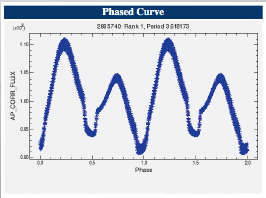Measuring eclipsing binaries in the Kepler data set
Based on materials originally developed by Julian van Eyken (NStED/IPAC) for the 2010 Sagan Exoplanet Workshop. This group project was entitled "Measuring Eclipsing Binary Star Parameters from Kepler Data."
Introduction
Binary stars are ubiquitous -- only ~50% of stellar systems are single stars. People study binary systems to better understand stellar parameters (mass, radii, distances, etc.) Without binary stars, many of these "fundamental parameters" are uncalibrated, e.g., many of these measurements can only be done in binary systems. Planetary transits are "special cases" of binary transits, where the secondary companion is much less massive than the primary. Binary light curves often have a lot more structure than planetary transit light curves; see figures.

